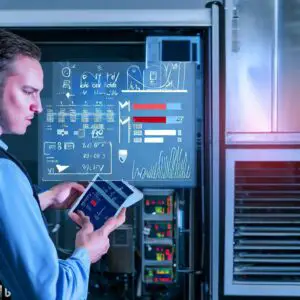If you’re in the business of storing goods, then temperature monitoring is a vital aspect of your operations. Temperature-sensitive products such as food, pharmaceuticals, and electronic items require specific storage conditions to maintain their quality and safety.
A warehouse temperature monitoring system is an essential tool that can help you keep track of the temperature levels in your facility and ensure that your products remain in optimal condition. With a warehouse temperature monitoring system, you can monitor the temperature within different zones of your facility remotely.
The system uses sensors installed in various areas of the warehouse to measure the temperature continuously. This information is then transmitted to a central hub, where it’s analyzed and used to generate reports that provide detailed insights into the performance of your cooling systems.
Whether you are running a small warehouse or a large-scale operation, having a good temperature monitoring system in place is crucial for maintaining product quality and safety.
Importance Of Temperature Monitoring For Warehouses
 Temperature monitoring in warehouses is crucial for several reasons.
Temperature monitoring in warehouses is crucial for several reasons.
Firstly, it helps maintain the quality of products stored within them. Many goods, such as food and pharmaceuticals, have specific temperature requirements to remain safe and effective. Without proper monitoring, these products can spoil or become damaged, leading to financial losses and potential health hazards.
Secondly, temperature monitoring can help prevent equipment failures. Temperature-sensitive machinery used in warehouses, such as refrigeration units and HVAC systems, require consistent monitoring to ensure they are functioning properly. If temperatures fluctuate too much or go outside recommended ranges, these machines may fail or require costly repairs.
Lastly, temperature monitoring can aid in regulatory compliance. Many industries have strict regulations regarding temperature control and storage of certain products. Monitoring systems provide accurate data that can be used to demonstrate compliance with these regulations during audits or inspections.
By implementing a reliable warehouse temperature monitoring system, companies can ensure the safety and quality of their products while also avoiding costly equipment failures and complying with regulations.
How Warehouse Temperature Monitoring Systems Work
As discussed in the previous section, temperature monitoring is crucial for warehouses to ensure that products are stored at the right temperature. A warehouse temperature monitoring system can help companies keep track of the conditions within their storage facility.
But how do these systems work?
Firstly, a warehouse temperature monitoring system typically consists of sensors placed throughout the facility. These sensors measure the temperature and humidity levels and send this information to a central hub or software.
The data collected by these sensors can be accessed in real-time by employees who need to monitor the conditions within the warehouse. Secondly, some temperature monitoring systems use cloud-based software to store and analyze data. This allows for easy access from any location with an internet connection.
Additionally, some systems may also come equipped with alerts that notify employees when temperatures fall outside of pre-set ranges. Overall, a warehouse temperature monitoring system is essential for ensuring that products are stored at the correct temperature and humidity levels.
By using sensors and cloud-based technology, companies can easily monitor conditions and receive alerts when necessary. With these systems in place, businesses can prevent spoilage and costly losses due to improper storage conditions.
Benefits Of Using A Warehouse Temperature Monitoring System
 Implementing a warehouse temperature monitoring system has proven to be a wise investment for many businesses in various industries. The benefits of having this technology in place go beyond just maintaining optimal conditions for stored goods. By using such a system, businesses can improve their operations, increase efficiency and reduce overall costs.
Implementing a warehouse temperature monitoring system has proven to be a wise investment for many businesses in various industries. The benefits of having this technology in place go beyond just maintaining optimal conditions for stored goods. By using such a system, businesses can improve their operations, increase efficiency and reduce overall costs.
Firstly, a temperature monitoring system allows for real-time tracking of environmental conditions within the warehouse. This means that any deviations from the preset temperature range can be quickly detected and addressed before they become significant issues. This not only prevents spoilage or damage to goods but also ensures compliance with industry regulations.
Secondly, with the ability to track temperature data over time, businesses can identify patterns and trends that may affect their supply chain or impact future decision-making. For example, if certain products consistently require lower temperatures than others, businesses can adjust their storage strategies accordingly and optimize space utilization.
Lastly, implementing a temperature monitoring system can help businesses save money by reducing energy consumption and maintenance costs associated with HVAC systems. With accurate environmental data at hand, HVAC systems can be fine-tuned to operate more efficiently without sacrificing product quality or safety.
Overall, incorporating a warehouse temperature monitoring system into business operations is essential for those looking to improve operational efficiency while reducing costs. By ensuring consistent environmental conditions for stored goods, optimizing storage space utilization, and reducing energy consumption through efficient HVAC management, businesses can improve their bottom line while providing high-quality products to customers.
Here is a detailed comparison table between some Warehouse Temperature Monitoring System solutions:
| Solution Name | Features | Price | Accuracy | Alert System | Cloud-based mobile mobile | Mobile App |
|---|---|---|---|---|---|---|
| TempSen | Real-time temperature tracking, customizable alerts, historical data storage, 24/7 customer support | $199 per sensor | +/- 0.5°C | SMS, email, push notification | Yes | Yes |
| Elpro | Wireless sensors, real-time temperature monitoring, automatic alerts, data logging | Contact for pricing | +/- 0.1°C | SMS, email, phone call | Yes | Yes |
| Swift Sensors | Wireless sensors, real-time temperature tracking, customizable alerts, cloud-based data storage | $279 per sensor | +/- 0.5°C | SMS, email, push notification | Yes | Yes |
| Monnit | Wireless sensors, customizable alerts, cloud-based data storage, analytics dashboard | Contact for pricing | +/- 0.5°C | SMS, email, voice call | Yes | Yes |
| Tive | Wireless sensors, real-time temperature tracking, customizable alerts, cloud-based data storage | Contact for pricing | +/- 0.5°C | SMS, email, push notification | Yes | Yes |
| Vaisala | Wireless sensors, real-time temperature monitoring, customizable alerts, cloud-based data storage | Contact for pricing | +/- 0.5°C | SMS, email, voice call | Yes | Yes |
The above comparison table shows some of the main features and specifications of different Warehouse Temperature Monitoring System solutions available on the market. The solutions vary in price, accuracy, alert system, cloud-based capabilities, and mobile app availability.
It is important to carefully consider these factors when choosing a Warehouse Temperature Monitoring System solution to ensure that it meets the specific needs and requirements of your business. Additionally, it may be helpful to consult with a professional to determine the best solution for your specific situation.
Factors To Consider When Choosing A Temperature Monitoring System
When choosing a temperature monitoring system for your warehouse, there are several factors to consider.
First and foremost, you need to consider the type of products stored in your facility. Different products have different temperature requirements and tolerance your monitoring system must bestem can maintain the correct temperature range at all times.
Another factor to consider is the size of your warehouse. A larger facility may require more sensors and monitoring devices to ensure accurate and comprehensive coverage. Additionally, you’ll want to think about the layout of your warehouse and whether thereare anyy areas that may prove to be temperature fluctuations.
Lastly, it’s important to consider the accuracy and reliability of the monitoring system you choose. Look for a system with real-time monitoring capabilities, as well as alarms or notifications that will alert you immediately if there is a deviation from the desired temperature range.
This will help ensure that any issues are addressed quickly, before they can cause damage or spoilage to your products.
Overall, choosing the right temperature monitoring system is crucial for ensuring product safety and quality in your warehouse. By considering factors such as product type, warehouse size and layout, and accuracy/reliable ility of the system, you can make an informed decision that meets the specific needs of your facility.
Best Practices For Ensuring Accurate Temperature Monitoring In Warehouses
When it comes to ensuring accurate temperature monitoring in warehouses, there are a few best practices that you should keep in mind. These practices can help prevent costly errors and ensure that your products remain safe for consumption.
Firstly, it is important to regularly calibrate your temperature sensors. Over time, these sensors can become less accurate, which can lead to incorrect readings and potential spoilage of goods. By regularly calibrating your sensors, you can ensure that they are working correctly and providing accurate readings.
Secondly, it is recommended that you place your sensors strategically throughout the warehouse. This will allow you to monitor the temperature in different areas of the warehouse and identify any hotspots or areas where the temperature may be fluctuating more than usual. By identifying these areas early on, you can take corrective action before any damage occurs.
Lastly, it is important to have a plan in place for when temperatures do go out of range. This plan should include steps for identifying the root cause of the issue and taking corrective action as quickly as possible. By having a plan in place ahead of time, you can minimize any potential damage and ensure that your products remain safe for consumption.
Accuracy in temperature monitoring is crucial for maintaining product quality and safety standards. Following these best practices will help ensure that your warehouse operates at optimal levels while keeping your customers satisfied with high-quality products.
Conclusion
In conclusion, investing in a warehouse temperature monitoring system can greatly benefit businesses that rely on proper temperature control for their products.
These systems work by using sensors to constantly monitor temperature and send alerts if there are any deviations from the desired range.
By implementing a reliable temperature monitoring system, businesses can ensure their products remain safe and of high quality, while also avoiding costly losses due to spoilage or damage.
When choosing a temperature monitoring system, it is important to consider factors such as accuracy, ease of use, and integration with existing systems.
Additionally, following best practices such as regularly calibrating sensors and training employees on proper usage can help ensure accurate monitoring.
With a well-designed warehouse temperature monitoring system in place, businesses can have peace of mind knowing that their products are stored under optimal conditions.
